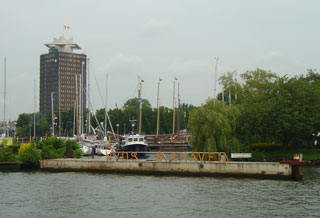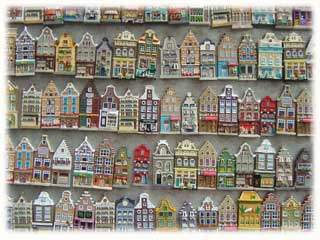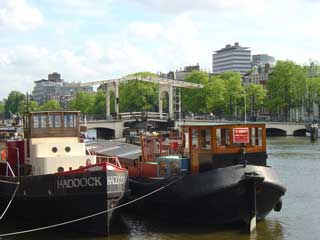Haarlem to Amsterdam
Wednesday 30th June
 We
tried to make a reasonably early start to our days cruise today but within half
a mile we arrived at the Spaarndam lock where we were kept waiting 45 minutes
for the arrival of a commercial barge. This seemed rather unfair as there was
hardly any change of water level, only a minor road over the accompanying bridge
and it was one of the few locks where a fee is payable. Eventually we were on
our way again and able to pass under the Rijksweg and Buitenhuizen bridges with
at least a metre to spare. After this we turned left into the Noordzeekanaal,
which joins Amsterdam to the sea at IJmuiden. The only hazards on this stretch
of the passage were the numerous barges joining from continuous commercial docks
and the high speed passenger ferries which approach rapidly from the horizon.
We
tried to make a reasonably early start to our days cruise today but within half
a mile we arrived at the Spaarndam lock where we were kept waiting 45 minutes
for the arrival of a commercial barge. This seemed rather unfair as there was
hardly any change of water level, only a minor road over the accompanying bridge
and it was one of the few locks where a fee is payable. Eventually we were on
our way again and able to pass under the Rijksweg and Buitenhuizen bridges with
at least a metre to spare. After this we turned left into the Noordzeekanaal,
which joins Amsterdam to the sea at IJmuiden. The only hazards on this stretch
of the passage were the numerous barges joining from continuous commercial docks
and the high speed passenger ferries which approach rapidly from the horizon.
 The
Sixhaven marina is the most popular place to stay in Amsterdam, the two alternatives
being either further out or of questionable security. The entrance is easily spotted
to the east of the Shell tower and once inside the wave break, boats are well
sheltered from the wash of passing traffic. Sixhaven gets very busy in high season,
and even at this quieter time we were soon blocked in by later arrivals. Major
construction work now lies between the yacht harbour and the free, 24 hour ferry
which crosses the River IJ to the centre of the city. A tube train is under construction
but with a further six years work scheduled the harbour master is resigned to
continued noise and disruption.
The
Sixhaven marina is the most popular place to stay in Amsterdam, the two alternatives
being either further out or of questionable security. The entrance is easily spotted
to the east of the Shell tower and once inside the wave break, boats are well
sheltered from the wash of passing traffic. Sixhaven gets very busy in high season,
and even at this quieter time we were soon blocked in by later arrivals. Major
construction work now lies between the yacht harbour and the free, 24 hour ferry
which crosses the River IJ to the centre of the city. A tube train is under construction
but with a further six years work scheduled the harbour master is resigned to
continued noise and disruption.
 Away
from the tourist tat which surrounds the Central Station, culture and history
abound along Amsterdam's famous canals. The elegant homes built in the city's
"golden age" were constructed to a standardised design to prevent subsidence
on the poor foundations, but the owner's stamp of individuality is evident in
the variety of decorative gables and cornices.
Away
from the tourist tat which surrounds the Central Station, culture and history
abound along Amsterdam's famous canals. The elegant homes built in the city's
"golden age" were constructed to a standardised design to prevent subsidence
on the poor foundations, but the owner's stamp of individuality is evident in
the variety of decorative gables and cornices.
 The
maritime museum, housed in the Dutch navy's former arsenal, is an eclectic collection,
dominated by the history of the East India Company and the Dutch battle for independence
from the Spanish. The Royal Barge, built in 1818 and last used in 1962 for Queen
Juliana's 25th wedding anniversary is a highlight of the visit. The Resistance
Museum and the much visited Anne Frank House give a flavour of life in Amsterdam
during the war years and bring to life the persistent persecution of Jewish people.
The
maritime museum, housed in the Dutch navy's former arsenal, is an eclectic collection,
dominated by the history of the East India Company and the Dutch battle for independence
from the Spanish. The Royal Barge, built in 1818 and last used in 1962 for Queen
Juliana's 25th wedding anniversary is a highlight of the visit. The Resistance
Museum and the much visited Anne Frank House give a flavour of life in Amsterdam
during the war years and bring to life the persistent persecution of Jewish people.
Cruising Statistics
Distance: 11 nm
Total to date: 1047 nm
Avg Speed: 6 knots
Duration: 2 hours
Diesel: 36 litres
Wind: SW 3/4
Mooring:
€8
Electricity: Included
Bridges
Spaarndam sluisbrug (lift)
Rijksweg A9 (6.2m)
Buienhuizen (6.4m)
Charts
ANWB Waterkaart G
AC124 Noordzeekanaal